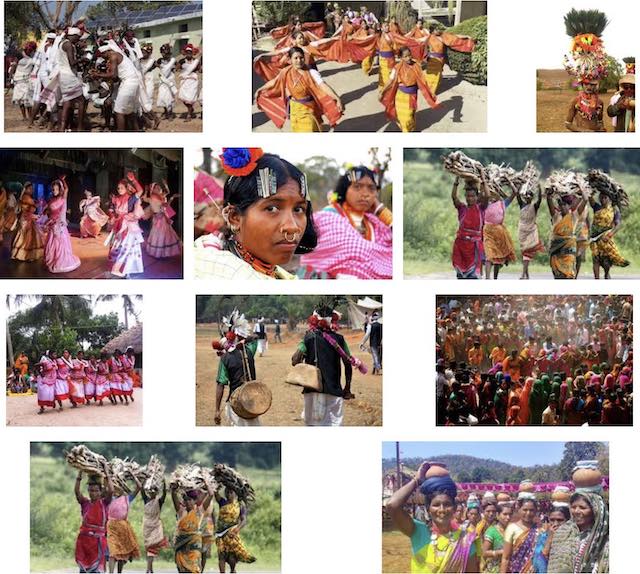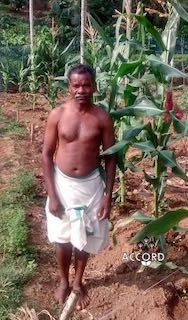Esther Elias, The Hindu, Sunday Magazine, October 20, 2012
Read the full article and view more photos here >>Vanya Orr walks the villages and forests of the Nilgiris to create self-sufficient communities, says Esther Elias.
Shola forests arch over a road winding up the Nilgiris to Kollimalai village, 10 km from Udhagamandalam. In a terraced organic farm there, a 79-year-old British woman skips over the slopes and plains, with a backpack slung over her shoulders. Cold winds from the hills mess with her cropped, grey hair. She pauses beside a row of lemongrass, pulls off a slender leaf, crushes it and says, “The cymbopogon growing higher up smells slightly warmer.” Twenty years in the Nilgiris have given Vanya Orr, and the thousand farmers she’s taught, a personal history with each of the 200 plants on the 1.7-acre farm.
Vanya’s link with the Nilgiris dates back six generations to when her grandmother Amy Ryan grew up in Ooty’s plantations with her grandparents. As a teacher in Bangalore’s Bishop Cotton School, Amy found love in James Peter Orr, then chairman of the Bombay Improvement Trust. James went back to Bombay to seek permission for marriage and wrote Amy a letter from every station the train halted. Nine decades later, in 1994, 60-year-old Vanya and her 80-year-old mother returned to India to travel that letter trail. They then went up the Nilgiris to find her mother’s ancestral home. The windows had fallen in and the doors were rotting but the house still stood; its ground floor home to cows. […]
Vanya stayed with the cows for three days hoping for some clarity of thought. When none arrived, she returned to the U.K., but friends handed her 500 pounds and sent her back with assistance from Foundation for Revitalisation of Local Health Traditions (FRLHT), Bangalore.
With FRLHT, Vanya began an organic Medicinal Plant Development Area (MPDA) in Dodabetta that employed primarily women and paid them the standard wage rate for men. “The village women taught me Tamil, gave me a bed and a mattress, food and care,” she says.
Organic agriculture was central to Vanya’s childhood spent on a farm in Wales. […]
While in the U.K., a report published by the Horticultural Department in the Nilgiris plagued Vanya’s mind. It said the collective debt of the Nilgiris’ farmers for agricultural chemicals crossed Rs.30 crore. Moreover, it deemed the majority of the grasslands unfit for agriculture due to aggressive farming. “I felt we needed to revive the land under ICU and hence came back in early 2001.”
Organic farm
With Jayalakshmi, a friend from her Cinchona days, Vanya began an organic farm and nursery in Lakanmanai. “We lived together in a loft above a cowshed and in the land around us we composted waste, made mulch and biodynamic sprays, and grew vegetables without disease since the herbs surrounding them protected them and us.” The seeds of Vanya’s organisation, Earth Trust (ET), were sown in this nursery. Today, three such nurseries exist. Over a thousand farmers have been trained in organic farming. At least 500 of them have reduced pesticide and fertilizer usage to 10 per cent. Over 100 have shifted over completely and market their produce through a farmers’ collective. […]
“Organic farming is about loving and respecting the Earth; acknowledging that she is a living being. She should have the same rights that humans do. Like it is illegal to kill, so should it be to wound the Earth.”
Vanya also returned to India drawn by the memory of a woman she knew in Dodabetta, who immolated herself because of domestic violence and died in Vanya’s arms. “You can’t watch something like that without it searing your consciousness. Alcoholism and anger stem from disempowerment; and women are often trapped in these situations. We wanted to give them tools to cope, not escape.” Thus began ET’s women empowerment initiatives.
In the heart of the community in Kateri village is a small hall where 18 women, mostly Badagas, gather daily. In a dialect more Kannada than Tamil they talk of husbands, children, health and food, as they create handmade frocks, petticoats, pillow covers and sweaters. From 2004, 16 other villages have hosted ET’s Income Generation Project for three months at a time. Women often join not knowing how to thread a needle. Many leave to open tailoring units of their own.
Training women
Intrinsic to Vanya’s efforts with women is a 12-module health programme. It teaches women about their bodies, stress management, common ailments and treatments through reflexology, yoga, meditation, massage, ayurveda, siddha and homeopathy. It focuses on locally cultivable medicinal herbs. Twelve village health workers from the Kota, Irula, Toda and Kurumba tribes have received this training in depth. Every morning, they travel over a hundred km from East Nilgiris to the herbal preparation unit on the Nilgiri Adivasi Welfare Association hospital grounds in Kollikarai village, Kotagiri. There, they make adathodai syrup, hair oils and massage oils, dry powders and triphala mixtures, among others, to be used in their villages. Between them they also take care of the health needs of 50 villages.
While Vanya’s work with the men and women of the Nilgiris has been prolific, it is projects with children that excite her most.
“Today, farming families do not want their children to touch the soil and tribal children don’t know their forefathers’ medicinal remedies. So much ancestral knowledge will die with this generation,” she says. To right this, ET began eco clubs in 16 Government middle schools. […]
Twenty-two children have used the techniques learnt in this garden to begin kitchen gardens in their homes. “When the parents see the first-fruits of the children’s effort, you should see the joy,” says Vanya.
Most schools have on-site gardens, but those without the space, plant and nurture the Shola forests around their schools. About 22 km from Thenalai, members of the Guernsey School Eco Club cleaned the forests nearby and collected 4,000 plastic bottles. These were stacked one above the other to build a greenhouse where indigenous Shola saplings are nursed.
This intimate, sustainable relationship with the Earth is what Vanya envisions for the Nilgiris. “We’re moving towards a technological world order where all our food, water and resources are shipped in from a centralised source. If a landslide occurs and villages are blocked off, there’s absolute havoc. These were once entirely self-sufficient communities. We need to go back to that stage,” she says.
Vanya’s work has brought her in contact with officials who’ve sometimes resented the “European in their patch”, but the stories of changed lives egg her on. She narrates the story of Sriram, who’d lost his parents and was living with his grandmother who wasn’t healthy enough to work. “He wasn’t doing too well in school. But at home, he’d created this beautiful garden off which his grandmother cooked each day. That’s the thing about India. Every emotion, every story is so powerful and concentrated. People are very very happy or very very sad or very very kind. India is very very.”
Source: In the heart of change – The HinduAddress : http://www.thehindu.com/features/magazine/in-the-heart-of-change/article4013129.ece
Date Visited: Sun Jul 28 2013 19:17:43 GMT+0200 (CEST)
Up-to-date reports by Indian experts and journalists
Search tips
Combine the name of any particular state, language or region with that of any tribal (Adivasi) community.
Add keywords of special interest (music, poetry, dance just as health, sacred grove and biodiversity); learn about the rights of Scheduled Tribes such as the “Forest Rights Act” (FRA); and the United Nations “Declaration on the Rights of Indigenous Peoples”, “Universal Declaration of Human Rights”, “women’s rights”, or “children’s right to education”.
Ask a question that includes “tribal” or “Adivasi”, for instance: “Adivasi way of life better?” (or “tribal way of life worse?”)
Specify any particular issue or news item (biodiversity, bonded labour and human trafficking, climate change, ecology, economic development, ethnobotany, ethnomedicine, global warming, hunter-gatherers in a particular region or state, prevention of rural poverty, water access).
For official figures include “scheduled tribe ST” along with a union state or region: e.g. “Chhattisgarh ST community”, “Himalayan tribe”, “Scheduled tribe Tamil Nadu census”, “ST Kerala census”, “Particularly Vulnerable Tribal Group Jharkhand”, “PVTG Rajasthan”, “Adivasi ST Kerala”, “Adibasi ST West Bengal” etc.
In case the Google Custom Search window is not displayed here try the following: (1) toggle between “Reader” and regular viewing; (2) in your browser’s Security settings select “Enable JavaScript” | More tips >>
Note: hyperlinks and quotes are meant for fact-checking and information purposes only | Disclaimer >>
List of websites covered by this Google custom search engine
Academia.edu (platform for academics to share research papers) – www.academia.edu
Archive.org – https://archive.org
Centre for Science and Environment – https://www.cseindia.org
Current Conservation – https://www.currentconservation.org
Development and Cooperation (D+C) https://www.dandc.eu
Down To Earth (India) – www.downtoearth.org.in
India Environment Portal – www.indiaenvironmentportal.org.in
Harnessing Nature Magazine – https://harnessingnature.online
Mongabay-India – https://india.mongabay.com
M S Swaminathan Research Foundation – www.mssrf.org
Navdanya (protecting India’s biodiversity based food heritage) – https://navdanya.org
Third World Network (Penang, Malaysia) – https://twn.my
The Shola Trust (nature conservation in the Nilgiri region) – www.thesholatrust.org

Indian online periodicals and platforms | Images view >>
~ ~ ~
Personalize your CustomSearch by combining other search words >>
(e.g. name of a tribal community and region, a craft, or dance and puppetry)
Research the above issues with the help of Shodhganga: A reservoir of theses from universities all over India, made available under Open Access >>
Note: hyperlinks and quotes are meant for fact-checking and information purposes only | Disclaimer >>
[Bold typeface added above for emphasis]
Tips for using interactive maps
Toggle to normal view (from reader view) should the interactive map not be displayed by your tablet, smartphone or pc browser
For details and hyperlinks click on the rectangular button (left on the map’s header)
Scroll and click on one of the markers for information of special interest
Explore India’s tribal cultural heritage with the help of another interactive map >>
